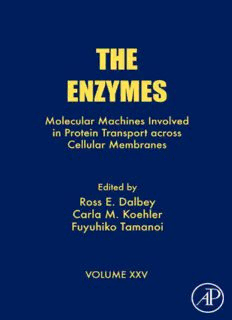
Molecular Machines Involved in Protein Transport across Cellular Membranes PDF
Preview Molecular Machines Involved in Protein Transport across Cellular Membranes
Contents Preface........................................................................xiii Part I: Crossing Bacterial Membranes 1. CotranslationalProteinTargetinginEscherichiacoli RONALDS.ULLERS,PIERREGENEVAUX,ANDJOENLUIRINK I. Introduction.....................................................................3 II. TheRibosome...................................................................4 III. ChaperonesandTargetingFactorsattheRibosomalTunnelExit.......................8 IV. SRP-MediatedTargeting.........................................................14 V. SelectionofProteinforSRP-MediatedTargeting....................................19 VI. ConcludingRemarks............................................................23 Acknowledgments...............................................................24 References.....................................................................24 2. SecProtein-ConductingChannelandSecA ELIO.VANDERSLUIS,NICONOUWEN,ANDARNOLDJ.M.DRIESSEN I. Abstract.......................................................................35 II. Introduction....................................................................35 III. Outline........................................................................37 IV. VariationandEvolutionoftheSecMachinery......................................37 V. SecAStructure,Function,andDynamics...........................................41 VI. SecYEGStructure,Function,andDynamics........................................51 VII. ConcludingRemarks............................................................59 References.....................................................................59 3. TargetingofProteinsbytheTwin-ArginineTranslocationSystemin BacteriaandChloroplasts SHARONMENDELANDCOLINROBINSON I. Introduction....................................................................69 II. BasicFeaturesofTatSystems,TheirDiscovery,andTheirDistribution.................70 III. tatGenesandMutantPhenotypes.................................................71 IV. TheTatSubunits:StructuresandConservedRegions ................................78 V. StructuresofTatComplexes......................................................80 VI. TatSignalPeptides..............................................................82 VII. TheTatMechanism.............................................................84 References.....................................................................87 v vi CONTENTS 4. YidC:AProteinwithMultipleFunctionsinBacterial MembraneBiogenesis NILCELEBIANDROSSE.DALBEY I. Introduction....................................................................93 II. TheYidCPathway..............................................................96 III. Sec–YidCPathway..............................................................97 IV. YidCSubstrates.................................................................99 V. YidCFamilyofProteins ........................................................100 VI. ConcludingRemarksandOutlook................................................105 References....................................................................105 5. DisulfideBondFormationEnzymes JAMESC.A.BARDWELL I. DisulfidesStabilizeSecretedProteins.............................................111 II. TheNeedforaCatalyst.........................................................112 III. DsbA:ThePrimaryOxidant.....................................................112 IV. StructureofDsbA..............................................................116 V. HowIsDsbAReoxidized?......................................................117 VI. ReoxidationofDsbB...........................................................119 VII. DisulfideBondIsomerization....................................................121 VIII. DsbDaDisulfideTransporter?...................................................123 References....................................................................125 6. TheIdentificationoftheYaeTComplexandItsRoleintheAssemblyof BacterialOuterMembraneb-BarrelProteins JULIANAMALINVERNIANDTHOMASJ.SILHAVY I. Abstract......................................................................129 II. Gram-NegativeBacterialEnvelope...............................................130 III. ProteinTransportAcrosstheBacterialEnvelope...................................130 IV. IdentificationofOMBiogenesisFactors:TheSearchforNeedlesinaHaystack.........135 V. ChemicalConditionality:TheYfgLConnectiontoOMAssembly.....................136 VI. IdentificationandCharacterizationoftheYaeTComplex............................138 VII. InteractionsAmongYaeTComplexMembers......................................141 VIII. POTRADomains..............................................................142 IX. PropertiesoftheYaeT-Likeb-BarrelDomains.....................................144 X. ConclusionsandFutureStudy ...................................................145 References....................................................................146 CONTENTS vii 7. TheFunctionoftheABCTransporterLolCDEinProteinTransporttothe OuterMembraneofE.coli SHIN-ICHIRONARITAANDHAJIMETOKUDA I. Abstract......................................................................151 II. Introduction...................................................................152 III. SortingofLipoproteinsbytheLolSystem.........................................157 Acknowledgments..............................................................170 References....................................................................170 Part II: Crossing Endoplasmic Reticulum Membranes 8. TheSignalRecognitionParticleandItsReceptorinER ProteinTargeting IAINL.MAINPRIZE,FELICIAVULCU,ANDDAVIDW.ANDREWS I. Abstract......................................................................177 II. Introduction...................................................................178 III. CotranslationalTranslocation:AHistoricalPerspective .............................180 IV. TargetingofProteinstotheERIsRegulatedbyUnusualGTPases ...................186 V. Structure–FunctionAnalysis.....................................................191 VI. Conclusions...................................................................200 Acknowledgments..............................................................200 References....................................................................201 9. TheTranslocationApparatusoftheEndoplasmicReticulum MARTINAALKENANDRAMANUJANS.HEGDE I. Abstract......................................................................207 II. TransloconsReceiveSubstratesviaTwoDistinctPathways..........................208 III. SubstrateRecognitionbytheERTransloconIsaDecisiveStepin ProteinTranslocation...........................................................209 IV. TheRemarkableDiversityofSequencesRecognizedbytheTranslocon...............213 V. TheMachineryofSignalSequenceRecognition....................................214 VI. ACombinedFrameworkforSignalandTMDRecognition ..........................216 VII. GatingoftheProtein-ConductingChanneloftheTranslocon ........................219 VIII. TheEnergeticsofProteinTranslocation...........................................223 IX. TheBiogenesisofMembraneProteins............................................225 X. LateralExitofTMDsfromtheTranslocon........................................228 XI. RegulationofProteinTranslocation..............................................231 References....................................................................236 viii CONTENTS 10. TheRoleofBiP/Kar2pintheTranslocationofProteinsAcrossthe ERMembrane KUNIONAKATSUKASAANDJEFFREYL.BRODSKY I. Abstract......................................................................245 II. Hsp70........................................................................246 III. ProteinTranslocationintotheER................................................250 IV. FoldingofNascentProteinsintheERandER-AssociatedDegradation(ERAD).......259 V. UnansweredQuestions .........................................................261 Acknowledgments..............................................................262 References....................................................................262 11. Calnexin,Calreticulin,andTheirAssociatedOxidoreductaseERp57 BRADLEYR.PEARSEANDDANIELN.HEBERT I. Abstract......................................................................275 II. Introduction...................................................................276 III. StructuralCharacteristicsofCalnexinandCalreticulin ..............................277 IV. TheRolesofCalnexinandCalreticulininGlycoproteinMaturationand QualityControl................................................................282 V. TheCalnexin-BindingCycleinYeast.............................................288 VI. ERp57,aMemberofthePDIFamilyofOxidoreductases............................289 VII. RedoxActivityofERp57 .......................................................292 VIII. TheRoleofERp57inGlycoproteinFolding.......................................294 IX. RegulationofCalciumSignaling .................................................296 X. Summary .....................................................................297 References....................................................................298 Part III: Crossing Mitochondrial Membranes 12. TOMandSAMMachineriesinMitochondrialProteinImportand OuterMembraneBiogenesis MICHAELJAMESDAGLEYANDTREVORLITHGOW I. Abstract......................................................................309 II. Introduction...................................................................310 III. TheTOMComplex ............................................................313 IV. TheSAMComplex.............................................................326 V. ConcludingRemarks...........................................................332 Acknowledgments..............................................................333 References....................................................................333 CONTENTS ix 13. TheRoleoftheMia40-Erv1DisulfideRelaySysteminImportandFolding ofProteinsoftheIntermembraneSpaceofMitochondria JOHANNESM.HERRMANN,KARLBIHLMAIER,ANDNIKOLAMESECKE I. Abstract......................................................................345 II. Introduction...................................................................346 III. ProteinImportRoutesintotheIMS..............................................347 IV. Mia40,anImportReceptorintheIMS............................................349 V. Erv1,aDisulfideOxidaseintheIMS .............................................351 VI. AModelofMia40-Erv1-MediatedImport.........................................357 VII. SubstrateProteinsoftheMia40-Erv1Pathway.....................................360 VIII. Perspectives...................................................................361 Acknowledgments..............................................................362 References....................................................................362 14. TheFunctionofTIM22intheInsertionofInnerMembraneProteins inMitochondria YAVUZOKTAY,ROBERTN.RAINEY,ANDCARLAM.KOEHLER I. Abstract......................................................................367 II. Introduction...................................................................368 III. PropertiesofPrecursorsthatUtilizetheTIM22ImportPathway......................370 IV. TheSmallTimProteins.........................................................373 V. TheTIM22InnerMembraneComplex............................................375 VI. DiseaseConnections............................................................377 References....................................................................379 15. TheRoleoftheTIM23ComplexandItsAssociatedMotorComplex inMitochondrialProteinImport JANDUDEK,BERNARDGUIARD,ANDPETERREHLING I. Abstract......................................................................387 II. Introduction...................................................................388 III. MitochondrialPresequenceProteins..............................................390 IV. ThePresequenceTranslocase:TIM23Complex ....................................392 V. EnergyRequirementforMatrixTranslocation:TheMotorComplex..................395 VI. ModelsofMotorFunction.......................................................398 VII. TransportofProteinsAcrossTwoMembranes.....................................400 VIII. ProteinTransportThroughTwoDifferentFormsofthePresequenceTranslocase.......402 Acknowledgments..............................................................403 References....................................................................403
Description: